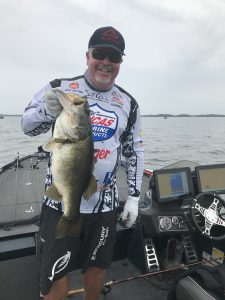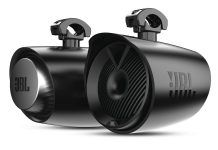It Just Takes ‘Some Brass And Glass And A Little Finesse’
 “Doodling is a technique for tough conditions,” says John Murray. “Why would you doodle if the fish are killing crankbaits?” Murray, who started his career in Arizona, is now one of the top professional bass anglers in the nation — known for bringing in big sacks when others are getting skunked. “Doodling isn’t a good way to find fish, but it’s the best way to take a lot of fish off a spot once you know they are there,” Murray adds. “In winter, once you locate fish, you can usually catch a bunch off the same spot.”
“Doodling is a technique for tough conditions,” says John Murray. “Why would you doodle if the fish are killing crankbaits?” Murray, who started his career in Arizona, is now one of the top professional bass anglers in the nation — known for bringing in big sacks when others are getting skunked. “Doodling isn’t a good way to find fish, but it’s the best way to take a lot of fish off a spot once you know they are there,” Murray adds. “In winter, once you locate fish, you can usually catch a bunch off the same spot.”
Finesse Fishing
Murray says that finesse fishing has gotten an undeserved reputation as a “little fish” technique. “To me,” he says, “finesse is more the presentation than the lure.” A lot of the anglers out West are catching huge bass doodling 12-inch hand-poured worms on light line with a 1/8-ounce sinker. The doodle rig uses a Texas-rigged worm rigged with a brass sinker and a glass bead. Slip the sinker on the line, then the bead, then tie the hook on. When you shake this rig gently, the brass and glass click together with a high-pitched sound that travels extremely well in the water. A lot of fishermen say it imitates a crawfish clicking.
Locating The Fish Is Key
Locating the fish is the key to success, and Murray relies on his electronics to find good structure in winter. “I don’t look for fish,” he emphasizes, “I look for structure at the right depth. I’ve caught some of my best bass in places where I didn’t see any fish on the graph.” A good depthfinder will show you the thermocline and baitfish once you learn to use it, Murray says. Taking the time to become thoroughly familiar with your unit is imperative.
In cold water, bass tend to migrate to more vertical structure. Bluffs and steep banks are worth investigating, and the best points are long ones near a channel so they have a steep drop-off on one side or another. Creek channels themselves are key locations, too, but a drop-off alone isn’t enough.
Successful Doodling
Successful doodling stimulates all of a bass’s senses. The clicking and shaking create vibration, but Murray takes further steps to ensure success. He relies on salty, hand-poured worms or Berkley Power Worms to get the fish to hang on. A good doodle worm has lots of salt or flavor.
Equipment Important
Since doodling is a light-line technique, the equipment you use can mean the difference between success and failure. A good doodle rod should have enough power to set the hook even with a lot of line out, and a fast, somewhat limber tip so the lure can be shaken easily. It doesn’t matter whether you use spinning or baitcasting gear, as long as the action is right and the rod is long enough to take up line quickly when you sweep to set the hook.
Immediate Hookset
Murray uses 8-pound-test line, and a straight-shank hook. “When you have a lot of light line out, it’s hard to get power in a hookset,” says John. A hook with no offset delivers more power to the point, and the hook must be strong and sharp. When a fish takes a doodle rig, the bite is simply a mushy feeling when you move the worm. The hookset needs to be immediate and the hook has to penetrate easily.
Soft Worms
The soft worms that are most effective for doodling have a tendency to slip down the hook shank, so pegging the worm to the hook by slipping a length of heavy monofilament line through the worm and the eye of the hook can help. Murray also pegs the glass bead onto the line with a few strands of rubber skirt material to keep it about half an inch away from the worm. This lets the brass sinker click against the bead without putting pressure on the worm, as well as giving the worm more action when the rig is shaken.
Structure Dictates Type
The type of structure you are fishing, and the position of the fish on or around that structure dictates the type of doodling that will work best. “Doodling is excellent for vertical structure,” says John Murray. “My favorite way to doodle a bluff is to stay right over it and move the boat instead of the worm.” He looks for a good piece of structure on the bluffs, like rocks or brush on a ledge at the right depth, then gets right over it and drops the worm down.
A Better Feel
“Doodling is shaking, not hopping or lifting,” he emphasizes, “you want to make as much noise and vibration as you can without moving the worm from the spot.” Murray has found that doodling works even better when you work uphill, so he will position his boat right over the structure, then drop his worm straight down. “You just shake the worm, then let it sit,” he says, “then you move it uphill a tiny bit and shake it some more.” He prefers to keep the line vertical so he can watch his graph — he gets a better feel for the lure that way.
All It Takes
Although bass fishing can be slow in the winter, an angler who knows what type of structure to look for and how to fish it can still manage to catch bass in cold water. All it takes is some brass and glass and a little finesse.
![]() Please scroll to the bottom of any article and leave us your outdoor experiences in the “Comments” section.
Please scroll to the bottom of any article and leave us your outdoor experiences in the “Comments” section.
More Arizona Fishing Resources
Click here to see a list of AZ Lakes AZ Pros Stories on Western Outdoor Times.
Click here to see a list of AZ Lakes AZ Pros Stories on Arizona Boating And Watersports
Arizona Rivers And Streams Publishers Note
© 2005-2022 Arizona Boating & Watersports. All Rights Reserved.































